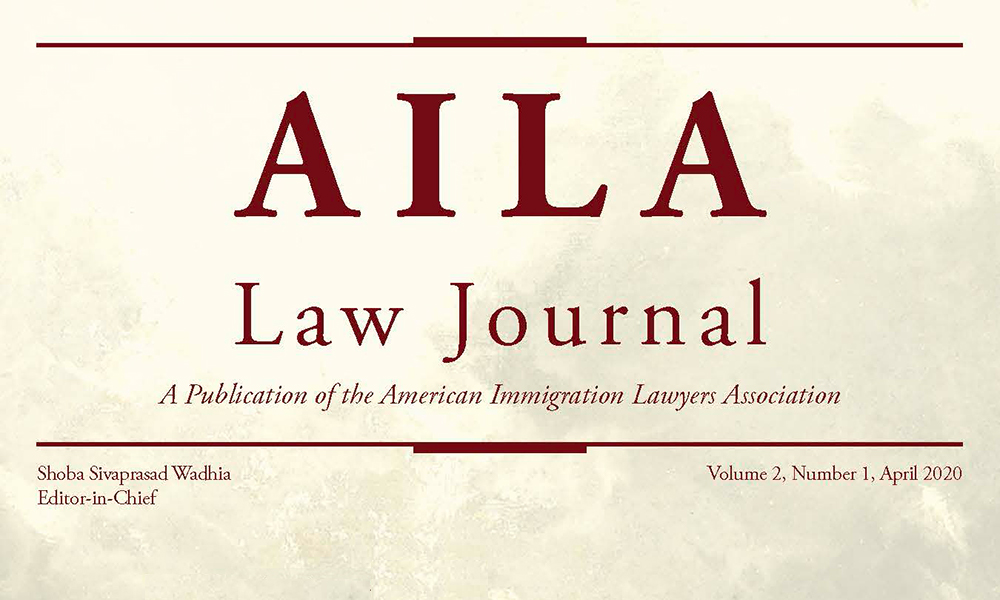We’re all adapting to the new work-from-home reality, sourcing masks to go to the grocery store and checking on our loved ones via Zoom. It’s a busy time, but I’m here to tell you, the AILA publications team continues to work tirelessly, hand in hand with our members to develop new, useful, and informative content. And I’m absolutely delighted to share that the Spring 2020 edition of the AILA Law Journal has just gone live! The Journal is a biannual effort led by legal scholar and professor Shoba Sivaprasad Wadhia, and published in partnership with Full Court Press, the publishing arm of Fastcase. The Journal features articles on current and pragmatic topics related to the rapidly changing immigration law landscape, in support of AILA’s mission to promote justice, advocate for fair and reasonable immigration law and policy, advance the quality of immigration and nationality law and practice, and enhance the professional development of its members.
The Spring 2020 edition includes five articles by a diverse group of immigration practitioners and scholars, including: a piece arguing against Chevron deference in asylum and withholding of removal cases, an article on vicarious trauma and ethical obligations for attorneys representing immigrant clients, an overview of the tax consequences of expatriating from the United States, a critique of the president’s call for a border wall, and a compilation of survey data illustrating how immigration attorneys rate some of the most popular immigration case management systems.
Hopefully I’ve managed to pique your interest with that, but here’s a bit more on each article: In “Enforcing/Protection: Arguing Against Chevron Deference in Asylum and Withholding of Removal Cases,” Professor Maureen A. Sweeney contends that contemporary Chevron jurisprudence supports an argument that courts should not defer to the Board of Immigration Appeals (BIA) or the Attorney General (AG) in matters of asylum and withholding of removal. She points to several factors that she asserts weigh against agency deference, including the treaty source of the government’s obligation to protect this population, the prosecutorial role of the Department of Justice (DOJ) in immigration enforcement, the lack of any special expertise on the part of the BIA and the AG in the areas of law that inform asylum and withholding law, and the extreme vulnerability of asylum seekers, generally.
Authors Hannah C. Cartwright, Lindsay M. Harris, Liana E. Montecinos, and Anam Rahman examine the consequences of vicarious trauma, compassion fatigue, and burnout on immigration practitioners in their paper, “Vicarious Trauma and Ethical Obligations for Attorneys Representing Immigrant Clients: A Call to Build Resilience Among the Immigration Bar.” The article analyzes the ethical obligations of immigration attorneys and ethical issues that arise with attorneys experiencing vicarious trauma—especially those engaged in removal defense and humanitarian and discretionary relief—identifies when and how barriers to recognizing, preventing, and responding to vicarious trauma can arise, and suggests practical ways that immigration attorneys can develop a “trauma stewardship practice” and seek to build resilience.
We’ve all heard that description of immigration law as being second in complexity only to tax law, right? Well, sometimes immigration law and tax law collide for even more complexity. Author Patrick J. McCormick stresses the importance for immigration practitioners to have a basic familiarity with the tax consequences of leaving the United States, particularly for those attorneys working with clients who either renounce citizenship or abandon green card holder status. In “The Tax Consequences of Expatriating from the United States,” he discusses the U.S. tax considerations in the expatriation context, including the tax benefits of expatriation, the special tax rules applicable upon departure, and useful strategies for planning for the tax consequences of expatriation.
In “Fake Problems with Faulty Solutions: Why a Physical Barrier Is Not a Viable Answer to Trump’s Purported ‘Crisis’ at the Border,” third-year law student Heather Adamick provides a historical overview of the evolving border between the United States and Mexico, beginning with the Adams-Onís Treaty of 1819 through the current day. Through her exploration of the history of the border wall, Ms. Adamick contends that construction of the physical barrier sought by Present Trump is an unnecessary expense that will not provide real solutions to our out-of-date immigration system.
Greg Siskind’s article seeks to help members of the immigration bar make more informed choices in their selection of immigration case management software by presenting the findings from his 2019 market survey that measured user satisfaction with the current immigration software products in the rapidly expanding marketplace. Mr. Siskind notes that while case management software is central to an immigration lawyer’s practice and can be one of the most expensive items in a law firm’s budget, there is no universal “rating system” for these products and immigration practitioners often rely on anecdotal evidence when choosing a product.
The AILA Law Journal is available for free to members as a member benefit, and AILALink subscribers can also access it on the AILALink database. A print subscription, which includes up to three copies of each issue, can be purchased through Fastcase. AILA encourages members to showcase their own research and scholarship through submissions to the Journal. The submission deadline for the Fall 2020 edition is June 1.







